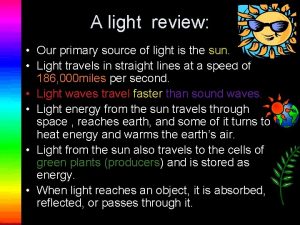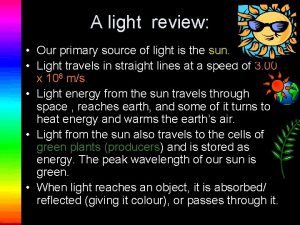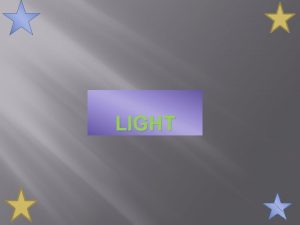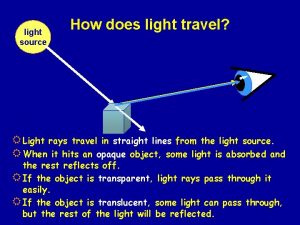A light review Our primary source of light


























- Slides: 26

A light review: • Our primary source of light is the sun. • Light travels in straight lines at a speed of 186, 000 miles per second. • Light waves travel faster than sound waves. • Light energy from the sun travels through space , reaches earth, and some of it turns to heat energy and warms the earth’s air. • Light from the sun also travels to the cells of green plants (producers) and is stored as energy. • When light reaches an object, it is absorbed, reflected, or passes through it.

Frequency Modulation or FM is a method of transmitting signals by changing the frequency of a wave. In this method of transmission the amplitude stays the same or constant while the frequency is manipulated. This is good only for short rangers

Amplitude Modulation or AM is a method of transmitting signals by changing the amplitude of a wave. The frequency of the wave remains constant. Normally for radio stations sound is converted into an electronic signal, transmitted and decoded when it arrives at it’s destination. AM signals can travel at much greater distance but at a lesser quality.

Wave Model of Electromagnetic Waves There are two specific models that must be understood in order to understand Electromagnetic Waves. These are the Wave Model of Light and the Particle Model of Light

The Wave Model of Light To help you understand the wave model of light, think of waves of light as being like transverse waves on a rope. If you shake a rope through a fence with vertical slats, only waves that vibrate up and down will pass through. If you shake the rope side to side, the waves will be blocked. A polarizing filter acts like the slats in a fence. It allows only waves that virbrate in one direction to pass through

The Particle Model of Light Sometimes electro magnetic waves behave like a stream of particles. When a beam of light shines on some substances it causes tiny particles called electrons to move. The movement of electrons causes an electric current to flow. When electrons move so much that it is knocked out of the substance this is called the photoelectric effect. The photoelectric effect can be explained only by thinking of light as a stream of tiny packets, or particles of energy. Each packet of light energy is called a photon.

Summary of Wave Models All though it might be difficult to think of electromagnetic waves as being both particles and waves they have the characteristics of both and you need to understand both in order to understand electromagnetic waves.

Cell Phones and How They Work Cellular phones transmit and receive signals using high frequency microwaves. When you place a call on a cellular phone, the phone sends out microwaves. The microwaves are tagged with a unique number assigned to your phone. A tower picks up the microwaves and transfers the signal to a hub which then transfers the signal to who you are calling.

Review Question #31 By passing white light through a prism, you can tell–A –B –C –D that white light is actually a mixture of different colors the mass of the prism the original source of the light that blue light is brighter than white light

What is light really? Electromagnetic radiation waves • Light waves are three dimensional • Light waves vibrate in all planes around a center line. • The waves have high points called “crests. ” • Waves also have low points called “troughs. ” • *The distance from one crest to the next crest is called a “wavelength. ” • *The number of waves passing a given point in one second is called the “frequency. ” wavelength *A Science Museum of VA: Light Science Activity

*Electromagnetic Radiation • Electromagnetic radiation can be described in terms of a stream of photons. Each photon is traveling in a wave-like pattern, moving at the speed of light and carrying some amount of energy. • The only difference amongst radio waves, visible light, and gamma-rays is the amount of energy of the photons. *Slide info from NSTA 2004 conference

Remember radio waves are long…and gamma rays are small Radio-TV -Microwave- Infrared - VISIBLE -Ultraviolet -X-rays - Gamma- Cosmic

Radio (Longest electromagnetic waves) • Emitted by – Astronomical Objects – Radio Station Transmitters • Detected by – Ground based radio telescopes – *If you turn on a radio, it will convert the radio wave energy into sound energy.

Television • Shorter than radio, also used to carry messages (pictures & sound) to our TV sets. • *We can sense the TV waves around us with our televisions.

Microwave • Emitted by: – Gas clouds collapsing into stars – Microwave Ovens – Radar Stations – Cell Phones • Detected by – – Microwave Telescopes Food (heated) Cell phones Radar (systems)

Infrared (Heat or Thermal) Are you a source of infrared? YES you are! • Emitted by – Sun and stars (Near) – TV Remote Controls – Food Warming Lights (Thermal) – *Everything at room temperature or above, =HEAT • Detected by – Infrared Cameras – TVs, VCRs, – Your skin

Visible Each color is a different size wave. Red the longest & violet the shortest • Emitted by – The sun and other astronomical objects – Laser pointers – Light bulbs • Detected by – Cameras (film or digital) – Human eyes – Plants (red light) – Telescopes

Ultraviolet Sunburn / black light • Emitted by – – Tanning booths (A) The sun (A) Black light bulbs (B) UV lamps • Detected by – Space based UV detectors – UV Cameras – Flying insects (flies)

• Emitted by – – – X-ray Astronomical objects X-ray machines CAT scan machines Older televisions Radioactive minerals Airport luggage scanners • Detected by – Space based X-ray detectors – X-ray film – CCD detectors

Chandra X-ray Observatory *Slide from 2004 NSTA Conference • Chandra is designed to observe X-rays from high energy regions of the universe, such as the remnants of exploded stars. • The most sophisticated observatory built to date. • Deployed by the Space Shuttle Columbia on July 23, 1999,

Gamma Ray (Short electromagnetic waves but more energetic) • Emitted by – Radioactive materials – Exploding nuclear weapons – Gamma-ray bursts – Solar flares • Detected by • --Geiger counters – Gamma detectors and astronomical satellites – Medical imaging detectors

Sources of g-ray Emission • Black holes • Active Galaxies • Pulsars • Diffuse emission • Supernovae • Gamma-ray bursts • Unidentified

COSMIC Rays (The highest energy waves and the deadliest) • Cosmic rays come from deep space and cannot pass through the Earth.

• A great question! • Radio waves= (Buildings to human size); • Microwaves (Humans-beetles); • Infrared waves (Eye of a needle); Visible waves (microscopic size)! WOW! All the rest are the size of molecules, atomic nuclei and smaller. .


http: //spaceplace. nasa. gov/en/kids/cosmic/index. shtml#
 The primary source of light is
The primary source of light is Christ, be our light shine in our hearts
Christ, be our light shine in our hearts Primary and secondary light sources
Primary and secondary light sources Light light light chapter 23
Light light light chapter 23 Into the light chapter 22
Into the light chapter 22 Chapter 22
Chapter 22 Thinking language and intelligence
Thinking language and intelligence Our census our future
Our census our future Marcus aurelius our life is what our thoughts make it
Marcus aurelius our life is what our thoughts make it We bow our hearts we bend our knees
We bow our hearts we bend our knees Our census our future
Our census our future Our life is what our thoughts make it
Our life is what our thoughts make it A poem 'money-madness shows
A poem 'money-madness shows Awareness of ourselves and our environment is:
Awareness of ourselves and our environment is: Awareness of ourselves and our environment
Awareness of ourselves and our environment God our father christ our brother
God our father christ our brother Our future is in our hands quotes
Our future is in our hands quotes Our awareness of ourselves and our environment
Our awareness of ourselves and our environment Awareness of ourselves and our environment is
Awareness of ourselves and our environment is The sacraments source of our life in christ
The sacraments source of our life in christ Maßshirts
Maßshirts Our own english high school sharjah boys
Our own english high school sharjah boys What is a primary source
What is a primary source What is a secondary source
What is a secondary source Almanac primary or secondary source
Almanac primary or secondary source Autobiography using primary sources
Autobiography using primary sources Primary source outline
Primary source outline

















































